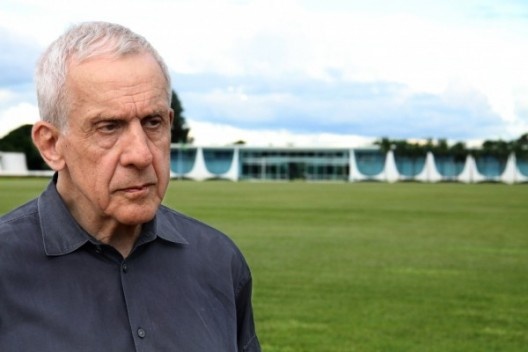
Kenneth Frampton na frente do Palácio da Alvorada, Brasília
Foto Roberto Fleury/UnB Agência
Nicolás Sica: It is difficult to start talking about you and your career as a critic without mentioning at least three of your most renowned works. I mean that these works are important both for you and for anyone who has started to study modern architecture in undergraduate and graduate degrees. I am talking about Critical History of Modern Architecture (3), Studies in Tectonic Culture (4) and the issues of Oppositions (5) magazine of which you were editor and co-founder. Lately, more precisely in 2008, you have participated in a publication on the new architecture of Chile called Pulso. It seems that after some years you are more focused on contemporary architecture. Is that correct? What are you working on now?
Kenneth Frampton: I have always been preoccupied with the evolution of contemporary architecture. All the successive editions of Modern Architecture: a Critical History from 1980 to the present have ended with an update chapter treating with some aspects of the more significant recent developments worldwide. Right now I am preoccupied with the preparation of an entirely new seminar on the theme of ‘world architecture’, emphasizing non-Eurocentric work in such places as Australia, Canada, Brazil, Africa, etc.
NS: You've been studying and critiquing (in the strict meaning of the word), for many years, modern architecture practiced and theorized by important architects of the last century, taking mainly as references Le Corbusier and Alvar Aalto. Are these studies, nowadays, an important reference for analyzing current architecture practiced throughout the world? Do you use these ideas of modernity, which for many are outmoded, as a basis on which to critiquing the architecture built currently?
KF: Surely the work of both these figures remains as a crucial legacy for the present, that is to say they are part of the modern tradition. Aalto in my opinion still represents a fundamental point of departure for the cultivation of a significant contemporary architecture.
NS: On the 13th of November this year (Nov. 13th of 2010) you were chair of a meeting called "Five Architects: A North American Anthology” (6), which was attended by five architectural firms in Canada and the USA. What reason did have you to meet the architects Steven Holl (from New York), Rick Joy (from Tucson), John & Patricia Patkau (from Vancouver), Stanley Saitowitz (from San Francisco) and Brigitte Shim + Howard Sutcliffe (from Toronto)? What do you think are the most important conclusions from the meeting?
KF: In putting together the seminar “Five Architects: a North American Anthology” I wanted, first and foremost, to draw the attention of the Columbia community to the exceptional level of architecture being realized over recent years in Canada; the cultural neighbor that we in the US continue to ignore due to the perennial provinciality of the center. The three American practices represented to some extent exemplary work from different parts of the country; from the Southwest, the Pacific Coast and the Eastern Seaboard. Apart from this what they all had in common was a certain phenomenological emphasis and a strong feeling for the importance of topography and light.
notes
3
Frampton, Kenneth. Modern Architecture: a Critical History. New York: Oxford University Press, 1980. 324 p.
4
Frampton, Kenneth. Studies in Tectonic Culture: The Poetics of Construction in Nineteenth and Twentieth Century Architecture. Cambridge: The MIT Press, 1995. 446 p.
5
Oppositions: journal for ideas and criticism in architecture. New York: Institute for Architecture and Urban Studies, 1973-1984. 26 v.
6
Five Architects: A North American Anthology. Event webpage: http://www.arch.columbia.edu/event/news-events/events/lecture-series/five-architects-north-american-anthology (accessed the 18th of March of 2012).



